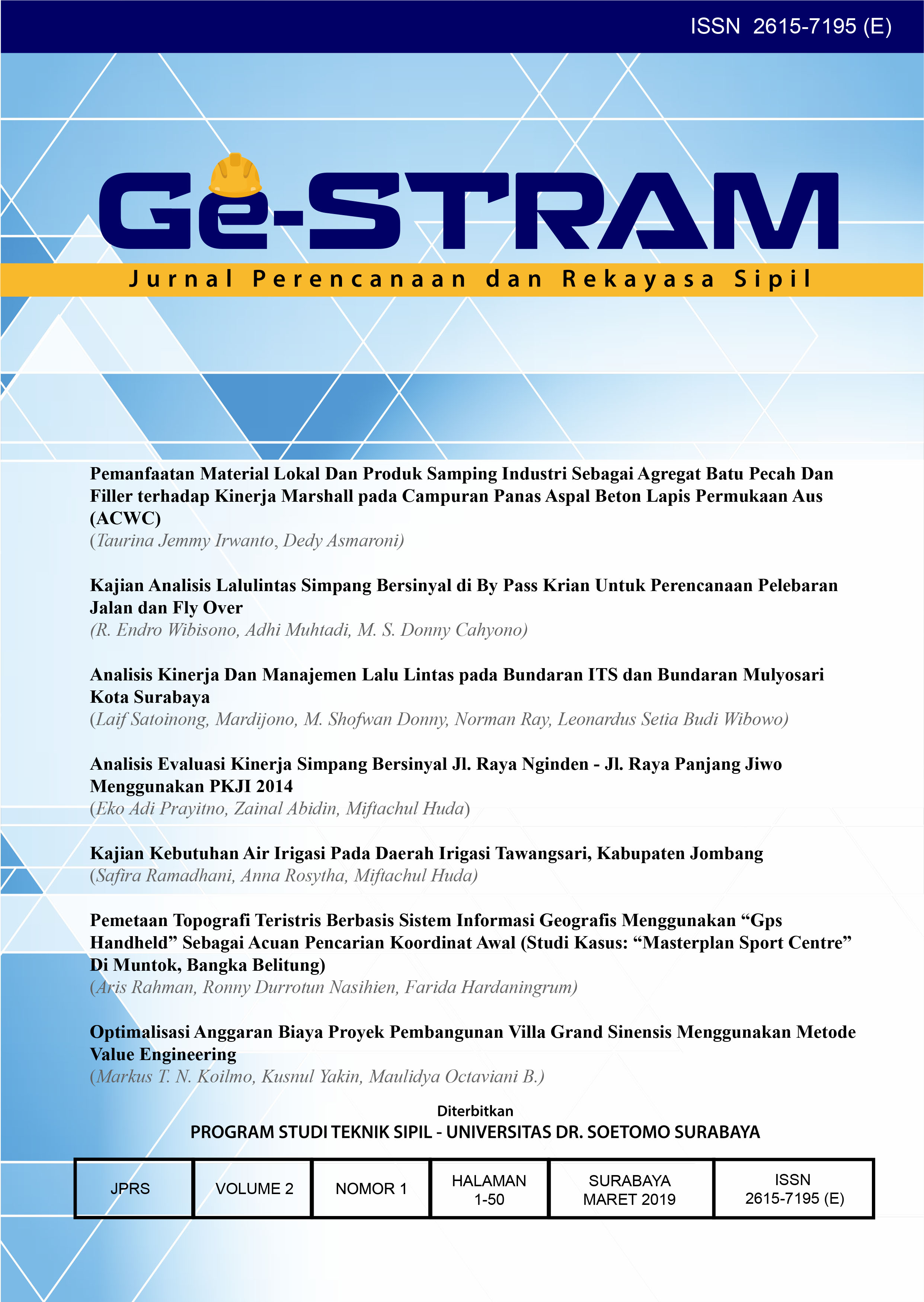Analisis Evaluasi Kinerja Simpang Bersinyal Jl. Raya Nginden - Jl. Raya Panjang Jiwo Menggunakan PKJI 2014
 Abstract views: 791
,
Abstract views: 791
,
 PDF downloads: 2490
PDF downloads: 2490
Abstract
Jl. Raya Nginden - Jl. Raya Panjang Jiwo intersection is an intersection that has a high density level, especially at peak hour, it can be seen from the length of the queue. The aim of this study is to determine the intersection performance in existing conditions and the next 5 (five) years and give a recommendation for improving an intersection performance. For analyzing intersection traffic performance using Indonesian Road Capacity Guidelines method (PKJI 2014). Primary data in this study are traffic volume, intersection geometric conditions, and cycle times. While secondary data in this study are population data, vehicle growth data, and traffic data from CCTV. Data retrieval in one day of weekday and one day of weekend. The results show that the degree of saturation (DJ) of existing (in 2018) on Wednesday, North approach is 1.45, South 1.35, West 0.76, East 1.49 and existing DJ on Sunday approaching North 0.80, South 0.88, West 0.69 and East 1.12. For traffic performance in the next five years (in 2023) with existing cycle and phase times, DJ on Wednesday, North approach is 2.36, South 2.20, West 1.24, East 2.43 and DJ values on Sunday, North approach is 1.30, South 1.42, West 0.95 and East 1.81. For traffic performance improving at the intersection is made an alternative with changing the cycle time and movement phase which show the results in existing DJ (2018) on Wednesday for North approach is 0.86, South 0.92, West 0.77, East 0.43 and DJ on Sunday for North approach is 0.52 , South 0.67, West 0.52 and East 0.28. For the next five years' traffic performance (in 2023), DJ on Wednesday for North approach is 1.45, South 1.67, West 1.35, East 0.91 and existing DJ on Sunday for North approach is 0.88, South 1.22, West 0.92 and East 0.60.
References
Huda, M., dan Muryanto, D. (2017). “Analisis Kinerja Lalu Lintas Sebelum dan Setelah Pembangunan Blitar Town Square”. Jurnal Rekayasa Teknik Sipil, Vol.1, No.2, Januari 2016, Jurusan Teknik Sipil Universitas Madura, Sumenep.
Huda, M., dan Muryanto, D. (2017). “Dampak Pembangunan SMPN 3 Blitar Terhadap Kinerja Lalu Lintas Sekitarnya”. Jurnal Rekayasa Teknik Sipil, Vol.2, No.1, Mei 2017, Jurusan Teknik Sipil Universitas Muhammadiyah Surabaya.
Badan Pusat Statistik Kota Surabaya (2018). “Kota Surabaya Dalam Angka 2018”. Surabaya
Direktorat Jenderal Bina Marga, 1992. Standar Perencanaan Geometrik untuk Jalan Perkotaan. Jakarta: Badan Penerbit Pekerjaan Umum.
Direktorat Jenderal Bina Marga, 1997. Manual Kapasitas Jalan Indonesia. Jakarta: Badan Penerbit Pekerjaan Umum.
Direktorat Jendral Bina Marga (2014). Pedoman Kapasitas Jalan Indonseia (PKJI). Jakarta.
Oglesby, Clarkson H dan Hicks. R. G, 1998, “Teknik Jalan Raya“, Jakarta: Erlangga.
Peraturan Mentri Perubungan Republik Indonesia Nomor PM 96 Taun 2015, Pedoman pengaturan kegiatan manajemen dan rekayasa lalu lintas.
Google EARTH, 2017. Peta Simpang Simpang Jl. Raya Nginden – Jl. Raya Panjang Jiwo. [Online] Available at:maps.google.co.id [tanggal pencitraan 17/7/2017].
Copyright (c) 2019 Eko Adi Prayitno, Zainal Abidin, Miftachul Huda

This work is licensed under a Creative Commons Attribution-ShareAlike 4.0 International License.
Authors who publish with this journal agree to the following terms:
- Authors retain copyright and grant the journal right of first publication with the work simultaneously licensed under a Creative Commons Attribution-ShareAlike 4.0 International License that allows others to share the work with an acknowledgement of the work's authorship and initial publication in this journal.
- Authors are able to enter into separate, additional contractual arrangements for the non-exclusive distribution of the journal's published version of the work (e.g., post it to an institutional repository or publish it in a book), with an acknowledgement of its initial publication in this journal.
- Authors are permitted and encouraged to post their work online (e.g., in institutional repositories or on their website) prior to and during the submission process, as it can lead to productive exchanges, as well as earlier and greater citation of published work (See The Effect of Open Access).

This work is licensed under a Creative Commons Attribution-ShareAlike 4.0 International License.















